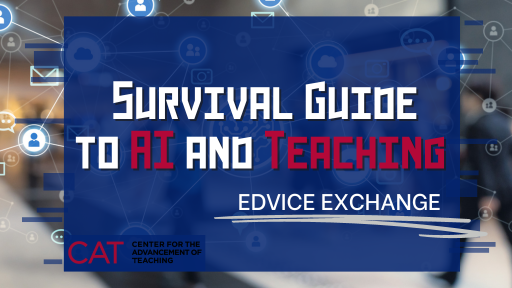Jonah Chambers & Jeff Rients

This week we’ll take a look at purposefully integrating the use of these AI tools into your course activities and assessments, particularly if the use of the tools can support student attainment of your learning goals. As with all educational technology, we generally recommend only those tools which support your previously identified goals And even when a tool does support your learning goals, consider the cognitive load of using the tool itself. Is the effort by the students to learn the tool worth the benefit gained? On the other hand, resisting the inevitable changes in our modern technological society is a well-trodden path to inconsequentiality. If you can, why not take advantage of these fabulous new AI tools to build more effective learning experiences for your students?
Here are some ways to make productive use of AI in your courses:
- Have students compete in creating the best prompt to elicit the most complete, useful, or interesting output to a course-related question or topic. Formulating a useful prompt requires clear articulation of the student’s own understanding, and comparing results allows students to practice their analytical skills.
- Ask students–on their own or in groups–to edit AI-generated texts. Editing could include fact checking, critiquing style, expanding upon, and adding references. Use collaborative documents (such as MS Word or Google Docs) to track changes to the original output. This process helps students develop critical thinking skills and digital literacy.
- Have students write annotated bibliographies based on guidelines you provide them and then compare those with AI-generated annotated bibliographies, noting where the AI-generated version produces errors or comes up short. This could work for other types of writing as well.
- Ask students to create a business plan, encouraging them to be as ambitious as possible and use the AI to provide ideas and feedback from a particular perspective.
- Task students with intentionally incorporating AI-generative tools into the writing process, such as to brainstorm paper topics, generate outlines, and proofread text they have written. You may want to check out these resources: Need an AI essay writer? Here’s how ChatGPT (and other chatbots) can help and How to… use ChatGPT to boost your writing.
- Share AI-generated responses with students to establish a new baseline of acceptable work, then expect better from them! Assign follow-up work that pushes student thinking further up Bloom’s Taxonomy.
- Allow students to submit an AI-generated first draft of a paper early in the semester, then focus their efforts on the revision process. Students submit both the AI draft and their revised version in a collaborative document (such as MS Word or Google Docs) so that you can track changes and see the version history.
- Per this paper, have students provide you with the list of the prompts they input and outputs they gathered in the process of writing a paper.
We’ve gathered some more specific activity and assignment ideas into this handy guide. Although any of these approaches will take some work to implement, this could be an opportunity for you to be an AI pioneer in your field, experimenting with possibilities these tools afford. You might even want to conduct a study to measure the effect of these tools on learning! Our resources on the Scholarship of Teaching and Learning can help you get started.
Keep in mind that you’ll have to decide to what extent and for what purposes students will be allowed to use AI, and then communicate those parameters clearly to students. That way students will understand clearly the expectations for your course. Key to any acceptable use of AI is transparency; you should insist that students identify any work that is AI generated. The CAT has developed sample syllabus statements that provide language for acceptable and unacceptable use of AI that can provide clarity to students and to the Office of Student Conduct for use in cases of academic misconduct.
Remember, although we are providing three different paths forward in the use of AI in your classroom, you don’t have to choose just one! A mix-and-match approach may best fit your learning environment.
In the next installment, we’ll look at how your students can learn valuable skills by integrating critical examination of generative AI tools themselves into your course activities and assessments.
Jonah Chambers is Senior Educational Technology Specialist at Temple’s Center for the Advancement of Teaching. Jeff Rients serves as the Center’s Associate Director of Teaching and Learning Innovation.